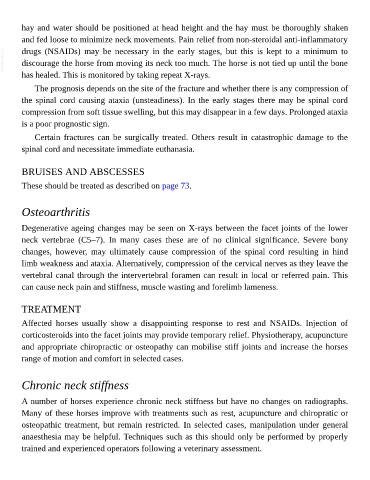Page 532 - The Veterinary Care of the Horse
P. 532
hay and water should be positioned at head height and the hay must be thoroughly shaken
and fed loose to minimize neck movements. Pain relief from non-steroidal anti-inflammatory
VetBooks.ir drugs (NSAIDs) may be necessary in the early stages, but this is kept to a minimum to
discourage the horse from moving its neck too much. The horse is not tied up until the bone
has healed. This is monitored by taking repeat X-rays.
The prognosis depends on the site of the fracture and whether there is any compression of
the spinal cord causing ataxia (unsteadiness). In the early stages there may be spinal cord
compression from soft tissue swelling, but this may disappear in a few days. Prolonged ataxia
is a poor prognostic sign.
Certain fractures can be surgically treated. Others result in catastrophic damage to the
spinal cord and necessitate immediate euthanasia.
BRUISES AND ABSCESSES
These should be treated as described on page 73.
Osteoarthritis
Degenerative ageing changes may be seen on X-rays between the facet joints of the lower
neck vertebrae (C5–7). In many cases these are of no clinical significance. Severe bony
changes, however, may ultimately cause compression of the spinal cord resulting in hind
limb weakness and ataxia. Alternatively, compression of the cervical nerves as they leave the
vertebral canal through the intervertebral foramen can result in local or referred pain. This
can cause neck pain and stiffness, muscle wasting and forelimb lameness.
TREATMENT
Affected horses usually show a disappointing response to rest and NSAIDs. Injection of
corticosteroids into the facet joints may provide temporary relief. Physiotherapy, acupuncture
and appropriate chiropractic or osteopathy can mobilise stiff joints and increase the horses
range of motion and comfort in selected cases.
Chronic neck stiffness
A number of horses experience chronic neck stiffness but have no changes on radiographs.
Many of these horses improve with treatments such as rest, acupuncture and chiropratic or
osteopathic treatment, but remain restricted. In selected cases, manipulation under general
anaesthesia may be helpful. Techniques such as this should only be performed by properly
trained and experienced operators following a veterinary assessment.

